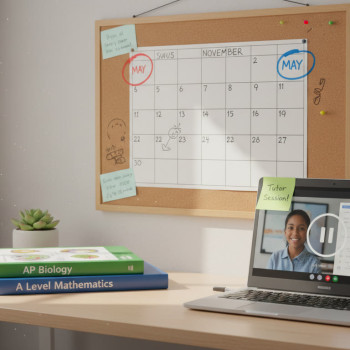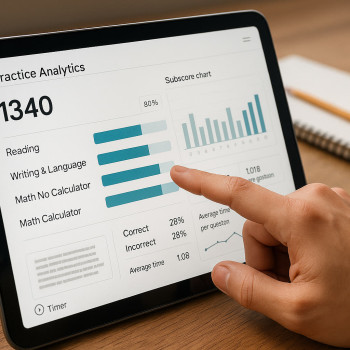Why Mock Exams Matter: A Short Conversation Between a Student and a Parent
Student: I ve taken a few practice tests online, but I still feel shaky when test day comes.
Parent: Maybe the problem isn t the number of practice tests it s how you take them.
This little exchange captures the truth: mock exams are only as useful as the way you run them. Sitting down with a stopwatch and an untimed practice set isn t the same as simulating test conditions. Whether you’re prepping for AP exams or the Digital SAT, the goal of a mock is to reveal realistic performance under pressure, diagnose patterns, and build reliable strategies. In this guide I ll walk you through a professional, practical protocol for running AP and SAT mocks at home plus how targeted support, like Sparkl s personalized tutoring, can make your practice exponentially more effective.
Overview: How AP and Digital SAT Mocks Are Similar and How They Differ
Before we dive into the step-by-step protocols, it helps to understand the backbone of each testing system:
- AP Exams focus on subject mastery history, calculus, biology, literature and more. Many AP exams combine multiple-choice and free-response sections, and some emphasize breadth versus depth depending on the subject.
- Digital SAT evaluates core reading, writing and math skills in a modular, timed format on a digital platform. The digital nature changes pacing, question navigation, and how you interact with passages and figures.
Common ground: both demand time management, stamina, and tactical approaches to question types. Differences: AP often requires written construction of knowledge and evidence-based explanations; the Digital SAT rewards speed, strategic guessing, and digital test-taking skills.
Before the Mock: Planning and Materials
Choose the Right Resources
Use official practice materials where possible. For AP, official College Board practice exams and released free-response questions are best for realism in question style and scoring. For the Digital SAT, use official practice modules that reflect the adaptive and digital format. If you re working with a tutor or with Sparkl s tailored tutoring ask them to help you select which released exams or high-quality practice sets match your current level.
Create a Realistic Schedule
Mock exams should mimic the real day. That means:
- Pick a start time. Take the test when you will take the real one (morning for most high school tests).
- Block out uninterrupted time. Don t schedule anything 30 minutes before or after.
- Plan a warm-up routine: light review, a short mindfulness or breathing exercise, and a quick nutritional plan (water + light snack).
Set Up Your Physical and Digital Test Space
Your environment should match testing conditions as closely as possible:
- Quiet room with a clear desk, comfortable chair, and a plain background.
- For the AP written portions, have lined paper, pens, and a timer visible but unobtrusive.
- For the Digital SAT, use the device (laptop or tablet) you plan to test on, with the same browser or test app if possible. Ensure charger and reliable internet but simulate conditions where internet is stable (do not practice with frequent network drops).

Mock Protocol: Step-by-Step for AP Exams
1. Simulate the Full Exam
Don t cherry-pick sections. Most AP exams have multiple sections and varied tasks multiple choice, short answer, long essay, lab-based questions. Run the full exam in one sitting or in the same sequence as the real test. Include the writing portion if it exists, because writing under fatigue is a different skill than writing while fresh.
2. Strict Timing and Breaks
Use a clear timer. Follow the College Board timing breakdown for each section exactly, and enforce any built-in breaks. If the real exam allows notes, calculators, or certain materials, let the same resources be available during your mock. The goal is accuracy in pacing and cognitive load.
3. Mark and Move
Teach yourself to flag and move on. With multiple choice, don t get stuck. With essays, spend the first few minutes outlining. Many high scorers allocate time per question or part of an essay and adhere to it. You want to create automatic pacing habits during mocks so that those habits carry over to test day.
4. Scoring and Rubrics
Scoring AP free-response requires alignment with the official rubric. If possible, use released scoring guidelines and score your own responses against them. If you have a tutor or teacher available or Sparkl s expert tutors get your free-response sections graded by an expert who can give specific feedback on thesis clarity, evidence use, and synthesis.
5. Reflective Debrief
After the mock, spend 45 90 minutes reviewing: identify question patterns (e.g., I lose points on synthesis questions ), stamina drops (e.g., my last essay was weaker ), and timing issues. Create a short action plan for the next week focusing on the weakest areas revealed by the mock.
Mock Protocol: Step-by-Step for Digital SAT
1. Use a Digital Platform Equivalent
Because the SAT is digital, practice on a device to get comfortable with navigation, highlighting tools, and answer selection. If you can’t access the exact test software, simulate with a full-screen browser setup that removes notifications.
2. Understand the Digital Time Blocks
Digital SAT sections are timed and can be adaptive across modules. Practice with the recommended section lengths and take note of the pacing per module. Remember: the digital format often requires faster toggling between questions and efficient use of on-screen annotations.
3. Practice Answer Strategies for Digital Interface
Learn shortcuts: how to mark a question, return to flagged items efficiently, and search within long passages or graphical data. Time saved on navigation can translate directly into more time for thinking.
4. Simulate Test Security and Time Pressure
Turn off notifications, close background apps, and avoid cheat sheet tabs. If you re in a family home, have someone act as an exam proctor to enforce breaks and prevent interruptions. The presence of an observing adult can help younger students take the mock seriously and practice under pressure.
Scoring, Feedback, and the Iterative Cycle
Mocks are diagnostic tools in an iterative cycle: test, score, analyze, adapt, and reteach. Use a table like the one below to track your results across multiple mocks so you can see trends rather than single-test noise.
| Test Date | Test Type | Raw Score / Section | Time Issues | Top 3 Errors | Next Steps |
|---|---|---|---|---|---|
| Aug 9, 2025 | AP Biology | MC: 40/60 FRQ: 18/24 | Rushed final FRQ | Data interpretation, FRQ evidence, Calc usage | Targeted FRQ practice + timed drills |
| Sep 21, 2025 | Digital SAT | Reading: 26/40 Math: 38/58 | Spent too long on long passage | Passage mapping, algebra errors, pacing | Passage skimming drills + timed problem sets |
Common Pitfalls and How to Avoid Them
Pitfall: Practicing Too Comfortably
It s easy to practice in a comfy chair with music and snacks but that doesn t simulate test stress. Make at least one mock exam per month an exact, silent simulation of test day. Parents can help maintain the environment if needed.
Pitfall: Ignoring Review
Many students take lots of practice tests but don t do the heavy lifting of reviewing every incorrect answer. Review is where learning happens. For AP free-response, rewrite stronger answers after reviewing rubrics. For SAT missed problems, re-solve without looking and create an error log.
Pitfall: Not Practicing Fatigue
Both AP and SAT require mental endurance. Schedule a full mock a few weeks before the exam to build stamina. Also practice the day-before routine: light review, early bedtime, and a consistent wake-up time.
How to Use Tutors and Personalized Programs Effectively
Tutors are amplifiers of practice quality not just cheerleaders. Here s how to use support well:
- Bring data: share your mock score table and error log so sessions are specific.
- Ask for modeled responses: have tutors annotate a top-scoring essay live so you can see thinking structure and phrasing.
- Use one-on-one time for high-value improvements: pacing strategies, essay structure, and targeted content gaps.
Sparkl s personalized tutoring, for example, blends 1-on-1 guidance with tailored study plans and AI-driven insights to identify weak spots fast. Tutors can assign focused mock segments, score free-response sections, and guide students to sustainable habits turning each mock from a score-report into a growth roadmap.
Parent Role: Encouraging, Not Fixing
Parents, your role is crucial but subtle. You can help by:
- Creating a consistent practice schedule.
- Providing a quiet, respected test environment.
- Helping with logistics on test day (food, wake-up, transportation), but not re-teaching content moments before the exam.
When parents use data from mocks to encourage realistic goals rather than pressure, students tend to respond with better focus and resilience.
Sample Mock Week Plan (6-Day Cycle)
This sample plan balances full-length mocks with targeted practice and rest.
- Day 1: Full AP mock (simulate entire exam, score FRQs)
- Day 2: Review Day deep error analysis, rewrite one FRQ
- Day 3: Digital SAT half-mock (digital interface focus)
- Day 4: Targeted skill day (math drills, evidence practice, or grammar)
- Day 5: Light practice + strategy work (timing drills, passage mapping)
- Day 6: Rest and reflection review the week s progress and set goals
Real Examples: What Improvement Looks Like
Example A AP US History: A student scored low on comparative essays. After three timed FRQ rewrites with feedback and a focus on thesis + evidence, the student s rubric score improved by two points. The key was targeted practice and scoring calibration with a tutor.
Example B Digital SAT: A student had strong accuracy but poor timing in reading. After practicing digital annotation and splitting passages into timed chunks, reading section scores increased by about 40% on similar practice tests. The change was mostly tactical better passage triage and on-screen annotations.
Checklist Before Every Mock
- Choose the official or closely equivalent practice test.
- Set timer and enforce official section times.
- Prepare paper, pens, calculator policy aligned to the exam.
- Silence phone and remove distractions.
- Have a proctor/parent monitor quietly if possible.
- Plan a calm debrief period and time to score.
When to Seek Extra Help
If your mock scores stagnate after several cycles, or if your errors show the same underlying misconceptions (e.g., misunderstanding core concepts or chronic timing errors), it s time to adjust the preparation approach. Personalized tutoring can identify whether the blocker is knowledge, strategy, or test anxiety and tackle it directly. Sparkl s tailored study plans and expert tutors are designed to provide that kind of targeted intervention, combining human grading with AI-driven insights to focus practice where it matters most.
Final Thoughts: Make Every Mock Count
Mocks are not a checkbox they re a learning engine. The most effective students treat each mock as deliberate practice: set realistic conditions, score precisely and honestly, analyze with a data-first mindset, and apply targeted study between sessions. With disciplined mocks, strategic tutoring support like Sparkl s where useful, and a focus on reflection, the path from anxiety to confidence becomes a series of measurable steps rather than an unpredictable leap.
Parting Tip
Run a full, quiet, timed mock under real conditions at least three times before exam season: one early diagnostic, one mid-cycle to measure progress, and one as a final rehearsal. Use the insights to build specific micro-goals (e.g., improve FRQ thesis clarity or reduce time on long SAT passages by two minutes each ), and track those goals week-to-week. Preparation becomes less about luck and more about repeatable, test-ready habits.

Good luck and remember: practice is powerful, but practiced the right way, it s transformative. If you want a personalized mock plan or help reviewing your mock results, consider reaching out for tailored guidance so every practice test pushes you closer to your target score.

















No Comments
Leave a comment Cancel